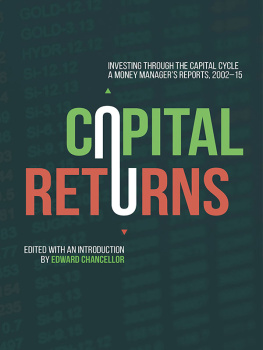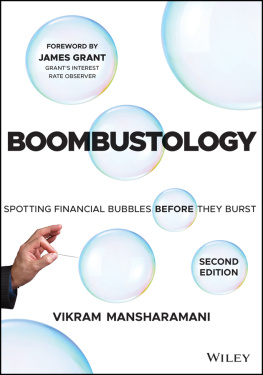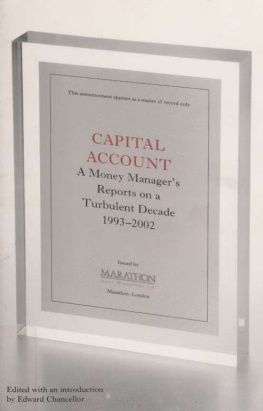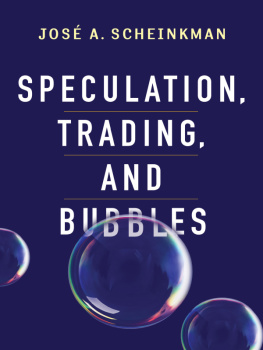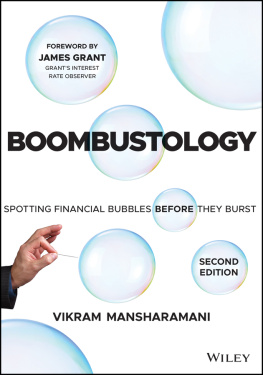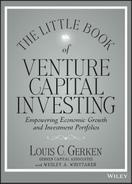CAPITAL RETURNS

CAPITAL
RETURNS
INVESTING THROUGH THE
CAPITAL CYCLE: A MONEY
MANAGERS REPORTS 200215
Edited by
EDWARD CHANCELLOR

Marathan Asset Management LLP 2016
Intoduction Edward Chancellor 2016
All rights reserved. No reproduction, copy or transmission of this publication may be made without written permission.
No portion of this publication may be reproduced, copied or transmitted save with written permission or in accordance with the provisions of the Copyright, Designs and Patents Act 1988, or under the terms of any licence permitting limited copying issued by the Copyright Licensing Agency, Saffron House, 610 Kirby Street, London EC1N 8TS.
Any person who does any unauthorized act in relation to this publication may be liable to criminal prosecution and civil claims for damages.
The author has asserted his right to be identified as the author of this work in accordance with the Copyright, Designs and Patents Act 1988.
First published 2016 by
PALGRAVE
Palgrave in the UK is an imprint of Macmillan Publishers Limited, registered in England, company number 785998, of 4 Crinan Street, London N1 9XW
Palgrave Macmillan in the US is a division of St Martins Press LLC, 175 Fifth Avenue, New York, NY 10010.
Palgrave is the global imprint of the above companies and is represented throughout the world.
Palgrave and Macmillan are registered trademarks in the United States, the United Kingdom, Europe and other countries
ISBN: 9781137571649
This book is printed on paper suitable for recycling and made from fully managed and sustained forest sources. Logging, pulping and manufacturing processes are expected to conform to the environmental regulations of the country of origin.
A catalogue record for this book is available from the British Library.
Library of Congress Catalogingin-Publication Data
Capital returns : investing through the capital cycle : a money managers reports 200215 / Edward Chancellor.
pages cm
ISBN 9781137571649
1. Business cycles. 2. Marathon Asset Management. 3. Speculation. I. Chancellor, Edward, 1962 editor. II. Marathon Asset Management.
HB3711.C353 2015
332.6dc23 2015025955
CONTENTS
LIST OF CHARTS, ILLUSTRATIONS AND TABLES
CHARTS
ILLUSTRATIONS
TABLES
FOREWORD
Marathon Asset Management LLP will shortly celebrate its 30th birthday. Over three decades, our investment philosophy has evolved, but two simple ideas about how capitalism works have always been paramount.
The first notion is that high returns tend to attract capital, just as low returns repel it. The resulting ebb and flow of capital affects the competitive environment of industries in often predictable ways what we like to call the capital cycle. Our job has been to analyze the dynamics of this cycle: to see when it is working and when it is broken, and how we can profit from it on behalf of our clients. The second guiding idea is that management skill in allocating capital is vital over the long-term. Picking managers who allocate capital in sensible ways is crucial to successful stock selection. The best managers understand the capital cycle as it operates in their industries and dont lose their heads in the good times.
We found that the kind of opportunities created by capital cycle analysis often have long gestation periods, as the timing of the pay-off was highly uncertain. As a result, we discovered that our approach has worked best when we invested in a relatively large number of stocks, holding onto them for long periods of time. This rather goes against the grain of our industry where the preference has been to hold concentrated portfolios, confirming a fund managers conviction in his or her ideas, albeit for shorter and shorter periods of time.
While we have sometimes struggled to explain our stance to consultants and other professionals in the financial services arena, it has always proved easier when it came to our clients. The latter pension funds, state funds, foundations and endowments, predominantly in the United States are often staffed by individuals with experience of working in non-financial businesses. A common refrain from them when explaining our process is thats just common sense. Fortunately for us, these ideas about how the capital cycle operates and how management allocates capital are not widely followed by our own competitors in the investment industry. This throws up investment opportunities for us around the world. While we have made innumerable errors over the years, our overall record in terms of relative performance has been favourable.
Furthermore, the investment approach has fared well under conditions of extreme stress and market madness. The Asian Crisis of the late 1990s and the technology, media and telecoms (TMT) bubble of the turn of the millennium were documented in our last collection of essays, Capital Account. Since 2004, the principal stress test was the long run up to, and calamitous aftermath of, the Global Financial Crisis (GFC). The challenges this posed for fund managers is the main story of this book. We were responsible for numerous howlers catching falling knives from the detritus of both the TMT bubble and the GFC, as well as numerous errors of judgment when it came to picking management teams. Our hall of shame includes the likes of Bear Stearns, Bradford & Bingley, Blockbuster, MBIA, HMV etc., etc. Nevertheless, overall performance has been gratifying, giving us confidence in the robustness of the investment philosophy.
This good fortune is matched by our success in persuading Edward Chancellor to reprise his role as editor of this volume of essays taken from the period 200215, as well as to write an insightful introduction. We thank him, along with Marathons employees, past and present, for their role in building this firm and creating this book.
Neil Ostrer, Founding Member
William Arah, Founding Member
June 2015
PREFACE
Capital Returns appears just over a decade after the publication of Marathons previous publication, Capital Account, which I also had a hand in editing. This new work is arranged along the same lines as its predecessor. The pieces here have been selected from the firms Global Investment Review, which appears eight times a year and typically contains six essays of around 1,500 words in length. The review, or GIR as it is known in-house, is written to inform Marathon clients of the firms investment approach and to provide real-time insights into developments in the investment world.
The essays collected in the current volume have been chosen because they exemplify Marathons capital cycle investment philosophy, which Marathon believes to be of some interest to the wider investing public (and perhaps even the odd economist if any can bring himself or herself to read a book devoid of equations and mathematical models). The process of selection inevitably leads to what is known in the investment world as survivorship bias: those essays which havent survived the test of time, or have turned out to be plain wrong, have been jettisoned, while the better investment calls have largely avoided the cull. The result is to make Marathon appear more clairvoyant than is actually the case one could quickly put together a far larger volume of duff pieces! My intention has not been to flatter the authors prescience, but rather to find interesting examples of capital cycle analysis, as applied by Marathons analysts over the past decade.
Next page
